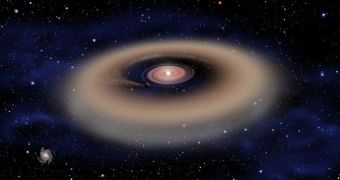For many years, astronomers have been looking for exoplanets around Sun-like stars, as they believe that these celestial bodies have the highest chances of harboring planets similar to our own. However, in recent studies, it has been demonstrated that planetary formation is a direct, natural byproduct of stellar formation, which means that even stars several times more massive than our Sun could have exoplanets around them. But these celestial bodies may not be the most suitable places to find extraterrestrial life, experts at the Search for Extra-Terrestrial Intelligence (SETI) initiative say, quoted by PhysOrg.
Harvard-Smithsonian Center for Astrophysics (CfA) expert Xavier Koenig believes that even larger stars show evidence of “planetary formation on fast forward.” He made the announcement yesterday, at the 215th meeting of the American Astronomical Society (AAS), in Washington DC. The expert reveals that, together with colleagues from the National Optical Astronomy Observatory (NOAO), the CfA team looked at a specific region of the constellation Cassiopeia, namely the W5 stellar nursery. In this area of intense stellar formation, which the group analyzed using NASA's Spitzer Space Telescope, the researchers found massive evidence of protoplanetary disks around young stars.
They also used information gathered by the ground-based Two Micron All-Sky Survey (2MASS) for the study. In infrared wavelengths, the disks were made obvious. More than 500 type A and B stars were the targets of the new investigation, and it was demonstrated that some ten percent of them (50 stars) had evidence of the dusty disks around them. Fifteen of these stars also exhibited central clearings, which is a clear indicator that Jupiter-sized planets formed there, clearing their orbit of other debris. Protoplanetary disks are the remnants left behind by the gas and dust clouds that collapse and then ignite, before forming a new star.
“The gravity of a Jupiter-sized object could easily clear the inner disk out to a radius of 10 to 20 astronomical units, which is what we see,” NOAO expert Lori Allen explains. She also says that, while most of the stars in W5 are between two and five million years old (which makes them extremely young), most have already lost the raw materials needed to form planets. Therefore, she proposes, for type A and B stars, exoplanets must form very early on, or not at all. The harsh conditions also mean that there are very little chances life would have the possibility to develop at these locations.
The habitable zones around these giant stars are a lot farther from their surface than the Earth is from the Sun. This is due to the fact that type A and B stars have a mass of two to 15 times larger than our star's. They also release more energy, are more luminous, and tend to live very short, troubled lives, of between ten and 500 million years. The Sun's total life will span more than ten billion years before it turns into a white dwarf, astronomers estimate.
“These stars aren't good targets in the hunt for extraterrestrials, but they give us a great new way to get a better understanding of planet formation,” Koenig concludes.

 14 DAY TRIAL //
14 DAY TRIAL //